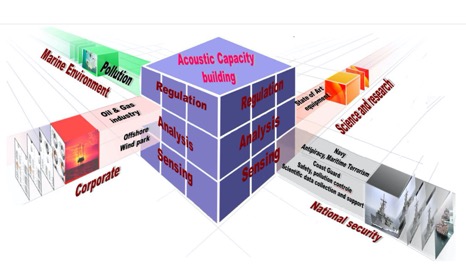Underwater Domain Awareness (UDA) Framework for River Systems in the North East
The Brahmaputra and the Barak rivers have played a critical role in shaping the culture, heritage and economy of the North East. There is potential for more, and it is essential that we build capabilities and capacities for the safe, secure and sustainable growth of the region with optimum utilization of the resources in the rivers.
- The ‘safe’ aspect addresses the disaster management efforts originating from the river – it could mean prevention and post event rehabilitation.
- The ‘secure’ aspect represents the security concerns that may originate from the river or even endanger assets in the river. The volatile security situation in the region does demand fresh initiatives that are able to comprehensively address the security concerns.
- ‘Sustainable growth’ pertains to economic growth with minimal degradation to the river flora and fauna.
Underwater Domain Awareness (UDA) is a concept that addresses our ability to monitor all the developments in the underwater region and possibly prevent adverse events. The UDA represents the following stakeholders:
- The disaster management authorities responsible for ensuring safe surroundings. Preventing a disaster may not be always possible, but with better awareness the loss of life and property can be minimized.
- The security apparatus responsible for providing a secure atmosphere that can minimize subversive activities on the river both by external and internal elements.
- The economic activities driven by the river, like inland water transport, fishing, underwater resource exploration and exploitation, etc., can be efficiently managed with effective UDA. The acoustic habitat degradation originating from such activities can also be better managed with enhanced UDA, leading to sustainable growth.
- The scientific and the research community needs to engage and continuously update our knowledge and access of the multiple aspects of the underwater domain. The regulators on the other hand need to know the pattern of exploitation to manage a sustainable plan.
The comprehensive UDA framework is presented in Fig. 1. The underlying requirement for all the stakeholders is to know the developments in the underwater domain, make sense out of these developments and then respond effectively and efficiently to them before they take the shape of an event. The UDA needs to be understood on a comprehensive scale in its horizontal and vertical construct. The horizontal construct would be the resource availability in terms of technology, infrastructure, capability and capacity specific to the stakeholders or otherwise. The four sides represented by the stakeholders may vary based on their specific requirements. However, the core acoustic capacity and capability would remain the same for all of them, thus helping to overcome the challenges of the tropical littoral waters. The vertical construct is the hierarchy of establishing a comprehensive UDA. The first level or the ground level would be the sensing of the underwater domain for threats, resources and activities. The second level would be making sense of the data generated to plan security strategies, conservation plans and resource utilization plans. The next level would be to formulate and monitor a regulatory framework at the national, regional and global level.

The figure above gives a comprehensive way forward for the stakeholders to engage and interact. The individual cubes represent specific aspects that need to be addressed. The User-Academia-Industry partnership can be seamlessly formulated based on the user requirement, academic inputs and the industry interface represented by the specific cube. It will enable a more focused approach and a well defined interactive framework. Given the appropriate impetus, the UDA framework can address multiple challenges being faced by the nation today, particularly when we are at the cusp of embarking on an ambitious national waterway project. Multi-disciplinary and multi-functional entities can interact and contribute to seamlessly synergize their efforts towards a larger goal.
The concerns of the stakeholders need to be looked at from a techno-strategic framework. The science and technology aspects that can aid strategy formulation need to be discussed. The rivers in the North East deserve far more attention from multiple aspects, and knowledge of acoustic habitat and UDA do add another dimension to our understanding of the river ecosystem.
There is a critical requirement to address the following aspects:
- Underwater Domain Awareness (UDA) perspective regarding safe, secure and sustainable growth of the river systems in the North East.
- Identification of the security concerns arising from the river systems and possible mitigation strategies.
- Identification of economic opportunities to boost the socio-economic status of the local population and make them aware of the importance of the rivers.
- Capacity building and capability building directions for effective UDA to ensure safe, secure, sustainable growth for all in the region.
- Qualitative and quantitative assessment of acoustic habitat degradation (broadly for Shihu, the river dolphin, and other species) in the river ecosystem due to human intervention.
UDA is very well aligned to the Security and Growth for All in the Region (SAGAR) vision of the honourable PM. It encompasses the ideas of a smart digital India with high end technology integration to overcome the specific challenges of the river systems and marine ecosystems in the IOR. The effective UDA framework being a new initiative will require efforts in all the dimensions: Policy Support, Infrastructure Creation, Know-how Build-up and Human Resource Development. Pooling of Resources and Synergy of Efforts are the only way forward and stakeholders have to come together to evolve a nuanced strategic vision.

Dr. (Cdr.) Arnab Das
About Author
Director, Maritime Research Center, Pune


